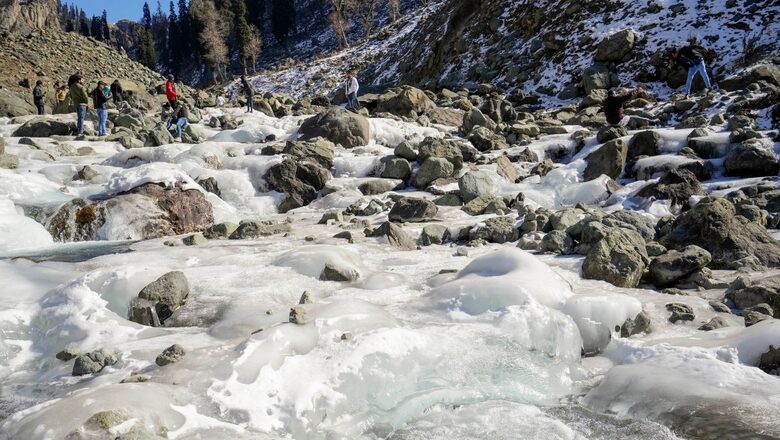
views
Cold wave conditions prevailed over several regions in north India on Thursday with Kashmir shivering at sub-zero temperature and Himachal Pradesh witnessing heavy snowfall and landslides that blocked more than 250 roads.
The national capital witnessed pleasant weather with the city recording a maximum temperature of 20.2 degrees Celsius, a notch below the season’s average.
The minimum temperature in Delhi settled at 8.2 degrees Celsius, according to the India Meteorological Department.
Meanwhile, according to official data, several parts of Jammu and Kashmir, including Srinagar city, witnessed the warmest January in 43 years.
There was no let-up in cold conditions in Punjab and Haryana too, with minimum temperatures staying below normal at several places.
On Thursday, Srinagar, the summer capital of Jammu and Kashmir, recorded a low of minus 5.2 degrees Celsius compared to previous night’s minus 2 degrees Celsius.
The minimum temperature in Gulmarg skiing resort in north Kashmir fell to minus 12 degrees Celsius, while Pahalgam tourist resort in south Kashmir, which serves as the base camp for the annual Amarnath yatra, recorded a low of minus 11.9 degrees Celsius.
Kokernag and Qazigund towns in south Kashmir recorded a low of minus 4.5 degrees and minus 6.4 degrees Celsius, respectively, officials said.
The minimum temperatures in Pahalgam, Gulmarg, Qazigund and Srinagar were around five degrees below normal for this time of the year. Although ‘Chilla-i-Kalan’ — the 40-day harshest winter period — ended earlier this week, the cold wave has continued in Kashmir.
In Himachal, Lahaul and Spiti district’s Kusumseri recorded a low of minus 14.2 degrees Celsius while the weather remained dry on Thursday.
Thick fog was witnessed in Sundernagar, Mandi and Bilaspur in the morning, reducing visibility to 500 metres while ground frost occurred in mid and higher hills, making commuting hazardous.
Restoration works are in full swing to open 254 roads including five national highways closed due to heavy snowfall and landslides, officials said. Narkanda and Kalpa recorded a low of minus 4.4 degrees and minus 4.2 degrees Celsius, respectively, followed by Manali and Bharmaur minus 2 degrees, Kufri minus 1.8 degrees, Bhuntar 0.1 degree, Sundernagar 0.2 degree and Shimla 0.9 degree Celsius.
The high-altitude tribal areas and other higher reaches reeled under piercing cold with mercury staying 15 to 22 degrees below freezing point.
All natural sources of water like lakes, springs, rivulets and tributaries of snow-fed rivers and a large stretch of Chandrabhaga River were frozen resulting in a sharp decrease in the discharge of water in Sutlej, Ravi, Beas and other rivers.
According to the emergency operation centre, 125 roads are closed for traffic in Lahaul and Spiti, 41 in Kullu, 37 in Chamba, 26 in Shimla and 24 in Mandi, while 80 transformers and 22 water supply schemes are disrupted in Himachal. Chandigarh, the joint capital of Punjab and Haryana, recorded a minimum of 7 degrees Celsius, two degrees below normal, according to the MeT department.
Among other places in Punjab, Amritsar shivered at 4.1 degrees Celsius, two degrees below normal, while minimum temperatures of Ludhiana and Patiala were 6.9 and 6.2 degrees Celsius, respectively. Pathankot, Bathinda, Faridkot and Gurdaspur experienced cold weather conditions at 3.9, 6.4, 6, and 4 degrees Celsius, respectively.
In neighbouring Haryana, Ambala recorded a minimum temperature of 7.6 degrees Celsius, one degree below normal. Hisar’s minimum was 7.5 degrees Celsius.
According to the Meteorological Centre Srinagar’s data, several parts of Jammu and Kashmir, including Srinagar city, witnessed the warmest January in 43 years.
In terms of snowfall or rains, Srinagar city witnessed the second driest January in the past four decades, recording a mere 3.0 mm of precipitation in the month this year, it said. According to the data, the mean Tmax (maximum temperature) recorded in January over Srinagar station was 11.9 degrees Celsius while for Gulmarg in north Kashmir and Banihal in Ramban district, it was 5.7 degrees Celsius and 16.9 degrees Celsius, respectively.
This is the highest mean maximum temperature for the month of January for these stations in the past 43 years, the MeT centre said in a post on X. “2024 January was one of the driest and warmest January in the last 43 years for most of the stations of J-K except the stations of plains of Jammu (Jammu, Samba and Kathua),” it added.
It said Jammu station, on the other hand, observed a mean maximum temperature of 13.4 degrees Celsius in January, which is the lowest since 1983.

















Comments
0 comment